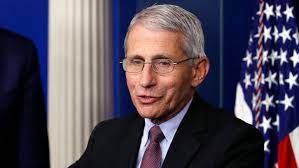As the AIDS crisis grew, some people pointed their rage at Dr. Anthony Fauci (shown here).
He wasa “Dr. Doom.” His infectious-disease team was filled with “incompetent idiocy,” said a leader of the ACT UP protest group, adding: ”I call you a murderer.”
Then the doctor came to an ACT UP meeting. In “Fauci” – the compelling Disney+ documentary – Peter Staley recalls thinking: “We’re dealing with Brooklyn here.”
This wasn’t a bland bureaucrats. Fauci sometimes agreed, sometimes didn’t; he listened.
And yes, he’s Brooklyn. He grew up in the Bensonhurst neighbothood, at a time, he says, when “everyone was striving; nothing was taken for granted.” (All quotes here are from the film.)
His grandparents were Italian immigrants; his father was a pharmacist who owned a neighborhood drug store, where the family worked. At Regis High School, Fauci was taught by Jesuit priests who emphasized public service.
That partly explains the opposite traits described by Jenny Fauci, the oldest of his three daughters. On one hand, he’s “funny, playful and just weird.” Still, she adds: “When he’s working – which is ALL the time – he’s laser-focused.”
The playful side may have allowed him to survive the give-and-take of his job. Fauci wasn’t offended by the brash AIDS protests, says activist David Barr. “He realized this was political theater.”
In high school, he was a downsized (5-foot-7) athlete, captain of the basketball team. (This will startle anyone who formed a mega-nerd image after he threw the worst first pitch in baseball history.)
In college (Holy Cross) and medical school (Columbia), he was serious. He was first in his class, worked at the National Institutes of Health and imagined having a “private practice on Park Avenue.”
That changed when he became fascinated by probing epidemics. He’s been at the NIH for 53 years and has headed its allergy and infectious disease program for 37 years.
That’s where he was when a small medical article in 1981 said five gay men had the same mysterious form of pneumonia. A month later, another story said 26; Fauci formed a three-man team to investigate.
To many protesters, the NIH move too slowly. They called it Nazis In Heathcare; Fauci said he took offense at first, but “started to feel almost an affinity to them.”
(In one protest, Staley was arrested on an NIH roof. A few minutes later, police were startled when he and Fauci accidentally crossed paths and greeted each other warmly. They remain friends and the film shows Staley trying to unsuccessfully to convince Fauci to get a Twitter account.)
Eventually, the NIH came up with the “drug cocktail” that has allowed people (including Staley) to live long lives with AIDS. But in Africa, people couldn’t afford it; Secretary of State Condoleezza Rice talked to President George W. Bush. “People … I trust said, ‘Unleash Fauci.’” Bush says.
Fauci visited Africa; then Bush announced a five-year, $15 billion plan. “It was just a huge moment,” says Bono, the singer and activist. Bill Gates calls it “a milestone.”
Yes, all of those people and more did interviews – even Bush, who has resisted post-presidency questions. Work on “Fauci” began in 2019, then took on fresh importance with COVID. The film jumps between AIDS, Ebola and COVID, sometimes having them share a split-screen.
Nowadays, Fauci – who turns 81 on Christmas Eve – is verbally battered by anti-vaccine people. “I’m the bad guy to an entire set of people,” he marvels.
He can handle it; we’re dealing with Brooklyn here.
